Quick search
CTRL+K
Quick search
CTRL+K

Warsaw or Warszawa is the capital of Poland and one of Eastern Europe’s great and historic capitals, and not many places like this city have experienced so turbulent times. In recent centuries, Warsaw has undergone several divisions and takeovers of power in Poland, and more recently about 85% of Warsaw was destroyed during World War II.
Time and again, the city has been rebuilt, and today the many beautiful buildings of historic Warsaw stand again in their original and noble exterior. The major investment in new construction in recent decades has provided a further dimension with a great architectural mix where the historical and new meet.
Fine museums depict, among other things, the turbulent years of war, but art museums and some of the many mansions and palaces are also worth a visit. There is also a huge selection of shopping and dining options, all with the warm Polish atmosphere and tasy food as the centerpiece.
The Old Town is the historic center of Warsaw, and it remains the center for tourists and locals when old and cozy streets and squares are to be seen and visited. Close to this is the new city, which has its own marketplace. From the 20th century’s post-war rebuilding and expansion of the city you can see the impressive Soviet culture and science palace, which is another city landmark.
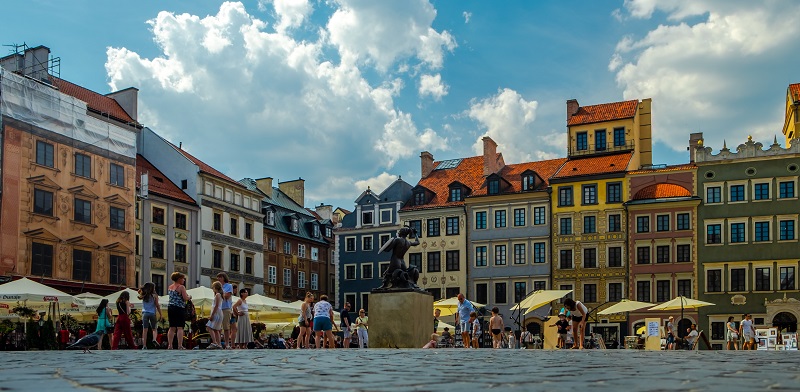
Warsaw’s Old Town is the city’s most atmospheric area with cobblestone streets and beautiful old architecture. Since its construction around the year 1300, the market square has been the center of the district and the whole of Warsaw, and today it is also the place for a lovely street life.
During the fighting in 1944 during World War II, the old town was almost completely destroyed. After the end of the war, it was quickly decided to reconstruct the city, which was the heart of Warsaw, and the reconstruction started after a very short time. The primary reconstruction was completed in the 1960s, and it was based, among other things, on Bernardo Bellotto’s paintings from the 18th century. There were also a number of preserved elements from the destroyed buildings, and these were reused for some parts.
The Old Town Market Square was already laid out in the 13th century and was Warsaw’s center for trade and politics. The city’s town hall was built on the square at the beginning of the 15th century, and was demolished in the 19th century. Around the square’s 73×93 meter area, there were buildings from the 14th century before World War II, but these were all destroyed in 1944. Today, the houses are reconstructions that were built between 1948 and 1953. In the work, preserved parts of the original buildings were used.
In the middle of the square stands a statue of a mermaid, which has been the city’s symbol since the 14th century. The statue holds a sword and a shield, which is a symbol that she will defend Warsaw if the city is ever threatened.
The story goes that two mermaid sisters swam in the Baltic Sea. One sister swam to Copenhagen, the other to Gdansk and further up the river Wisła until she stopped on the banks of what is now the Old Town of Warsaw. She thought it was beautiful and stayed there. A merchant captured her and held her captive to exhibit her for money, but local people freed her, and out of gratitude she will now always defend the town.
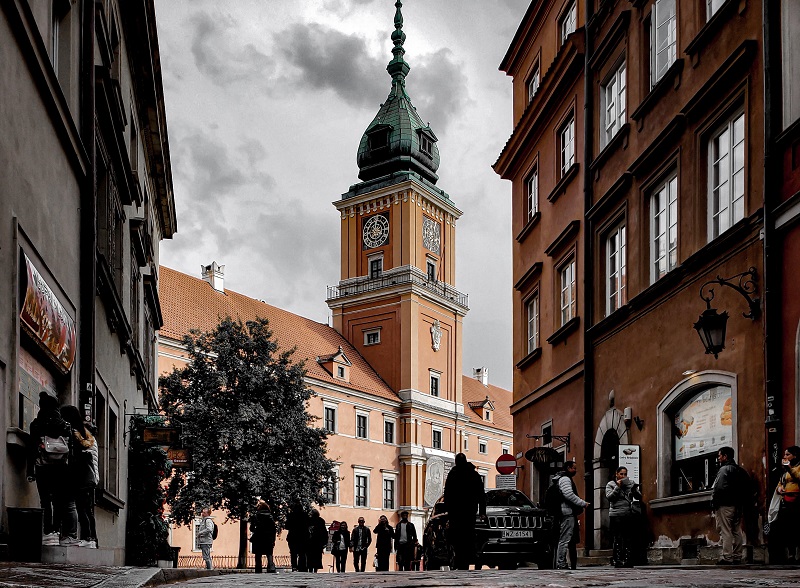
Warsaw’s Royal Castle was first built in the 14th century. In 1569, King Sigismund III moved his residence to the castle, and Warsaw became the capital of Poland. In 1598-1619, the castle was changed to its current basic form by Italian architects, and later reconstructions were carried out in Baroque style. During the 18th century, the facility was expanded with renovations of, among other things, the south wing, and here a beautiful Rococo facade was also added.
After the establishment of the Polish lower house, the Sejm, the castle housed both the royal family and the political assembly of Poland. However, the castle was destroyed in 1939, and it was finally blown up in 1944. The reconstruction of the castle was carried out in the years 1971-1988, and it now stands as before in the street view.
Many original pieces of furniture, statues and paintings are on display in the castle’s beautiful and richly decorated rooms. In terms of art, you can see works by Marcello Bacciarelli, Bernardo Bellotto’s almost photographic paintings of Warsaw and, not least, Jan Matejko’s magnificent paintings.
The Barbican is the old part of Warsaw’s northern gateway and is an integral part of the city’s defensive walls. Barbican was built in the 16th century and rebuilt in the 1950s.
From the establishment of the old town in the 1400s to the 1600s, the defensive walls consisted of a strong earthen rampart, but with both gates and actual walls, the defense was significantly improved. Remnants and rebuilt parts of Warsaw’s city walls remain all around the old town, you can see them by walking along Podwale Street from the Barbican.
Ulica Krakowskie Przedmieście is a street that, together with its southern extension, Ulica Nowy Świat, form two of the city’s most beautiful historic streets. At the same time, they form the first part of the King’s Road, which is the old road of the kings from the castle in the old and central part of the city to the summer castle of Wilanow, located immediately south of Warsaw.
Magnificent mansions like pearls on a string have been built along the streets over time, which you quickly get an impression of when you take a walk here today. In addition to beautiful mansions, you can see several interesting churches and monuments on the way.
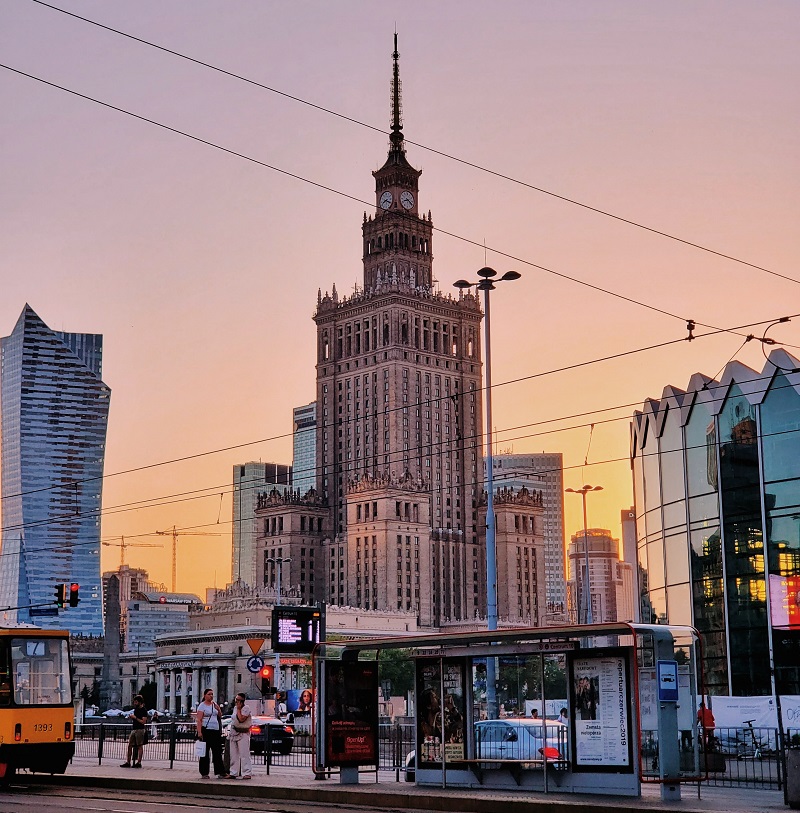
The Warsaw Palace of Culture and Science was built in 1952-1955 on the idea of the leader of the Soviet Union, Josef Stalin, and given as a gift from the Soviet population to the inhabitants of Warsaw and Poland.
The building style is typically Stalinist and is best known from the buildings of the so-called “Seven Sisters” in Moscow, of which Moscow University is among the best known of the sisters. According to the plan, there should have been an eighth sister in Moscow, but this was not built in the Russian capital. Architecturally, the building in Warsaw is believed to be a smaller version of the planned one, which is how it was built anyway.
At the time of construction, the palace was one of Europe’s largest buildings and, at 231 metres, also one of the tallest. The many floors and large buildings on the ground floor are built in an opulent style. The interior consisted of, among other things, cinemas, a swimming pool, theatres, museums and the country’s largest conference hall.
There are 42 floors in the building and more than 3,200 rooms and halls. On the 30th floor there is a viewing balcony from which there is an excellent view of the Polish capital.
In the Palace of Culture and Science there are museums for technology and science, Muzeum Techniki, as well as for evolution; Muzeum Evolution. There are also changing exhibitions, fairs and other public activities here.
Fotoplastikon is a viewer of three-dimensional images from the early 1900s. It is the only one left in Europe of the hundreds that were set up in many major cities.
The technique behind Fotoplastikon was invented and developed in Germany at the end of the 19th century; there they were called Kaiserpanorama. The three-dimensional images were produced with a dual-lens camera, and the display of the images gave viewers a fantastic illusion of reality.
With picture screenings, you can sense the atmosphere from the city in the 1900s and get lovely impressions from lovely places around the globe. The visit is at the same time an exciting experience of historical technology.
Lazienki Park is one of Warsaw’s true oases, and many of the city’s residents go here to relax among the many trees and beautiful buildings or to visit one of the cafes in the park. The word Lazienki refers to the bathing facilities that Stanisław Lubomiski built here in 1683. The bath was taken over by King Stanisław II August, who rebuilt it into the current Palace by the Water, which was to become the first of the many buildings that have been erected in the large park.
The park was laid out and was to function with buildings as a summer residence and excursion destination for the Polish monarchs. The park was laid out 1774-1784, and the various small buildings were often erected without any real purpose. They were simply to decorate, and by the way they were often used by the king’s female favourites.
There are a number of attractions in the park, and among the most important is the Palace by the Water/Pałac Na Wyspie. This palace was originally built as a bath house in 1683, but it was rebuilt in 1772-1793 by King Stanisław II August, who used it as a residence for a period. The building is neoclassical, designed by Tylman van Gameren and built on a particularly idyllic spot in the park.
The Theater by the Water/Teatr na Wyspie is located by the central lake in Lazienki Park. It was built as the facility’s classicist amphitheater in the years 1790-1793, loosely inspired by the ancient Herculaneum. The amphitheater is used today for theater performances and concerts.
The Old Orangery/Stara Pomarańczarnia is designed as an orangery for the Palace by the Water and for use during the king’s stay here. Today you can see a large sculpture collection from the 1600s-1900s in the orangery.
You can also see the Frederik Chopin Monument/Pomnik Fryderyka Chopina, erected in memory of the Polish composer Frederik Chopin. The monument was originally designed in 1904 by the artist Wacław Szymanowski. It was inaugurated in 1926, but during World War II the monument was melted down in Germany. It was rebuilt in 1957-1958 and erected on the original plinth that survived the war.
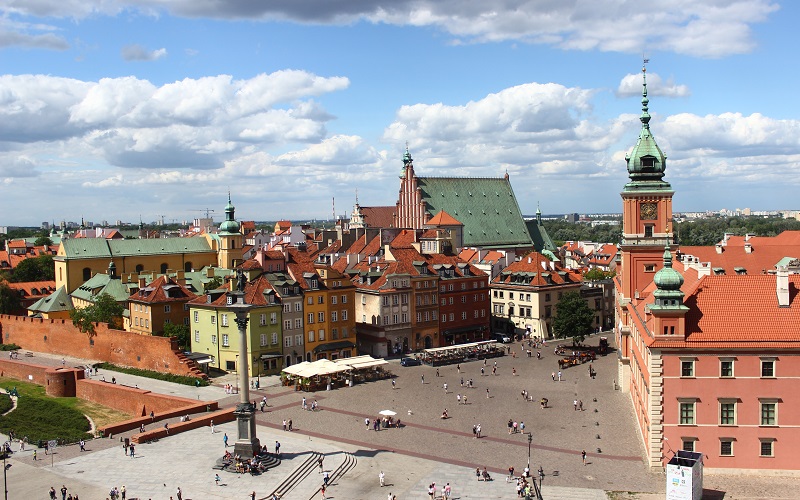
The Palace Square in Warsaw is located at the southern entrance to the Old Town proper. In the castle square, the 22 meter high Sigismund column from 1643-1644 can be seen. It was erected on the occasion of the move of the country’s capital to Warsaw.
Originally, the Corinthian column was made of red marble, but during the reconstruction in 1948-1949 granite was used instead. At the same time, the column was moved slightly so that it forms a beautiful focal point from the streets Podwale and Ulica Krakowskie Przedmieście.
Warsaw Cathedral was built during the 1300s and 1500s as an ordinary parish church. The building was a typical example of brick church construction in Mazovia, which is a historical region around Warsaw.
In 1798, it became the city’s cathedral, among other things after many major events had taken place here, e.g. the coronation of King Stanislav August Poniatowski in 1764 and the lower house, the Sejmen, swearing in the 1791 constitution.
The church was destroyed in 1944 but rebuilt as the original Gothic church in the years up to 1954. Many artists have helped decorate the church through individual parts.
Warsaw’s city history museum is housed in no less than eleven townhouses on the north side of the Old Town Market Square. The houses are all reconstructions after the almost total destruction of the area during the Second World War.
At the museum, you can see a permanent exhibition of the so-called seven ages of Warsaw, many of which focus on the city’s destruction during World War II and the colossal efforts to rebuild it in the following decades.
There are also paintings, sculptures, models, descriptions of leading citizens from the city’s history, pictures of buildings from the now-disappeared Warsaw and much more.
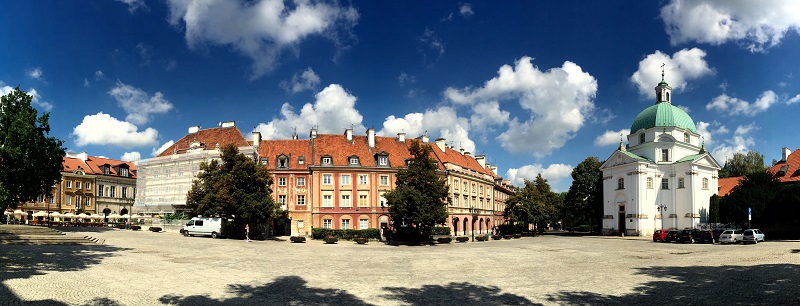
New Town Market Square is, as the name suggests, a market place in the so-called Nye By, which was a district that was founded at the beginning of the 15th century. The district was then outside the old town, which forms the oldest Warsaw. In the period 1680-1818, this town’s town hall was located on the square.
After the destruction during the Second World War, they chose to recreate the square in a style mainly from the 1700s and 1800s.
On the new market square you will find the white St. Kazimir’s Church, built in the years 1688-1692 under King Jan III Sobieski and according to drawings by Tylman van Gameren. The church is built in late baroque style, and here you can see, among other things, the grave of Jan III Sobieski’s granddaughter, Princess Marie Caroline de Bouillon. The church was destroyed in 1944, and after the end of World War II, it was rebuilt. The interior is a mixture of historical things and elements chosen during the interior design in the 1960s.
This church is the representative cathedral of Poland’s army, but its history goes back to the Piarists in the 17th century. Under King Władysław IV, the monks were given the right to build a new church on a piece of land very close to the city center.
The Piarists started the construction of the present church in 1660, and the Italian Constantino Tencalla is believed to have been the architect of the construction. The church was built for both the Piarists themselves, but also for teachers and students at the school Collegium Nobilium, which they had also established.
Construction lasted until 1682 due to a challenged economy, while the interior could only be completed in 1701. In the same year, the bishop of Poznan, Mikołaj Święcicki, consecrated the church. However, the long planning and construction time meant that the baroque used was not modern after a short time, and the church was therefore rebuilt in classicism in 1730.
After the November Uprising in Poland 1830-1831 against Russia, the church was confiscated and it was converted into a Russian Orthodox church. The most visible sign of this was the five onion domes that adorned the roof of the church, and in general the Russian reconstruction in the 1830s created a beautiful building with inspiration from the Russian Baroque, which is known not least from Saint Petersburg.
In connection with Polish independence after World War I, the church was reconstructed according to 17th-century drawings, but after bombings during World War II, the church had to be completely rebuilt between 1946 and 1960.
Bank Square is one of Warsaw’s large and central squares, and over the past centuries it has been one of the political, financial and cultural focal points of the city. In the middle of the square stands a statue of the Polish poet, Juliusz Słowacki, who wrote in the Romantic period in the 1800s. Around the square are several interesting buildings.
The Government Financial Palace/Pałac Komisji Rządowej Przychodów in Skarbu (Plac Bankowy 5) is a large classicist mansion with a Greek-inspired temple-style facade with protruding colonnaded halls. It was built in 1825 and erected to house a government commission, equivalent to today’s Ministry of Finance. The mansion was destroyed during World War II and rebuilt after the war. It is today the seat of the President of Warsaw and of the city government.
The Ministry of Finance/Pałac Ministra Skarbu (Plac Bankowy 3) is located in another of the square’s large and beautiful mansions. The building was built with inspiration from the Italian Renaissance 1825-1828 as an administration and seat for the Minister of Finance. Today, just like the neighboring building to the north, it is used as administrative premises for the Warsaw City Council.
Gmach d. Banku Polskiego in Giełdy (Plac Bankowy 1, ulica Elektoralna 2) is a former bank and stock exchange building, which is one of the finest examples of classicism in Warsaw. It was built in the years 1825-1828 according to Antonio Corazzi’s drawings. It was soon after expanded. Today, it stands out particularly beautifully in the streetscape with its arcades on two floors.
From 1957 to 1981, the building housed a museum of Poland’s revolutionary history, while today you can see the art museum John Paul II Collection/Kolekcja Imienia Jana Pawla 2. The collection, which was the private property of the Porczynski family, was donated to Poland and opened to the public in 1990. The collection contains around 450 paintings from the Renaissance to Impressionism, including works by, among others, Rubens and Rembrandt.
This is one of the museums dealing with the colossal significance of the Second World War for the Polish population and Warsaw. The name Pawiak alludes to the German Gestapo prison in the city in the years 1939-1945. Members of the Polish resistance movement against the German occupation were brought here, and in total more than 100,000 people passed through the prison. Outside the entrance to Pawiak, there is a monument commemorating the victims of the prison.
Historically, Pawiak was built as a prison 1829-1835. It served in 1863 as a transit point for the deportation of prisoners to Siberia, and in the Polish interwar period it was the city’s primary prison for male criminals. Today you cannot see some of the old prison buildings. The word Pawiak itself derives from the street’s former name, Ulica Pawia, meaning Peacock Street.
This mansion was built 1643-1645 as a residence for the commander of the Polish army. From the end of the 17th century until 1817, it belonged to the Radziwiłł family, and it was extended several times. The current appearance derives mainly from the last major rebuilding, in 1818-1819.
It was here in the building that the official agreement on the establishment of defense cooperation, the Warsaw Pact, was signed in 1955, thereby entering the Cold War era in the international history books. Since 1994, the beautiful facility has been the residence of the President of Poland.
In front of the palace stands an equestrian statue made in 1832 by the Danish artist Bertel Thorvaldsen; it depicts Prince Józef Poniatowski. The statue was destroyed during World War II and after the war a new casting was given as a gift from the citizens of the Danish capital, Copenhagen.
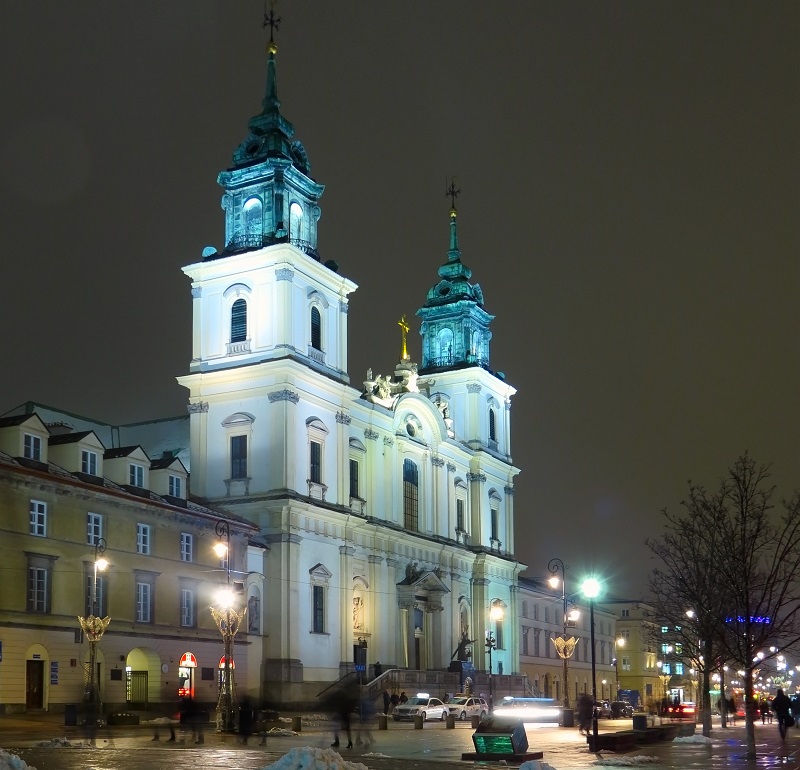
Kościół Świętego Krzyża is one of Warsaw’s most beautiful and impressive baroque churches. The elegantly decorated facade is one of the characteristic architectural highlights along the street Ulica Krakowskie Przedmieście.
There have been several churches on the site before the current one. The first was a wooden church from the 15th century, but as time went on, the city grew and with it the need for larger churches. During the ravages of the Swedes in the 1650s, the then church was destroyed, so a new one had to be built.
The baroque church was then built in the years 1679-1696 according to the design of the court architect Józef Szymon Bellotti. It included a modest exterior in the style of the Renaissance churches in the area, but the Baroque decoration and the appearance of the towers were soon added; it happened after two rebuilds in the 18th century.
On the facade you can see the figure of the church with Jesus and the cross, from which the name Holy Cross Church comes. The exterior design today is otherwise a simplified version of the church that was severely destroyed during World War II by German explosions. Inside, the formerly richly decorated room has not been recreated, but you can see a recreation of the church’s beautiful altar, where Tylman van Gameren’s National Altar/Ołtarz Ojczyzny from around the year 1700 was a model. In the church, an urn with composer Frederik Chopin’s heart has also been inserted into the wall.
Saint Joseph’s Church is one of Warsaw’s most beautiful churches from the Rococo period, and it stands as one of the distinctive buildings on the distinguished street, Ulica Krakowskie Przedmieście.
The first church on the site was a wooden church established in 1651 at the behest of the Polish Queen Marie Louise Gonzaga de Nevers, who established it for the Visitationists. For this reason, the church is also called the Visitation church/Kościół Wizytek.
The wooden church was burned during the Swedish invasion in the latter half of the 1650s, and a new one was founded in 1664. However, this church was not completed until it burned in 1695. It gave way to the current church, which was built from 1728 to completion in 1765.
The church’s interior offers both baroque and rococo, which is what the building is best known for. Sculptures, stucco, pulpit and the altar are all created by Efraim Szroeger, while you can enjoy works of art by several different Polish and foreign artists. The church’s tabernacle originally stood in the chapel of the Villa Regia in Warsaw, and it was donated here by Marie Louise Gonzaga de Nevers in 1654. The Villa Regia was the forerunner of the city’s university, which is also located on the street Ulica Krakowskie Przedmieście.
Behind the Tomb of the Unknown Soldier lies Warsaw’s first public park, the Saxon Garden, which was laid out in 1727. It was originally laid out according to French and Saxon models, but in the 19th century it was converted into a landscape garden.
Ogród Saski was previously laid out with bastions as part of Warsaw’s defense lines, but the area became a private park with the Morsztyn family building their residence here from 1666. The Saxon kings, Augustus II and Augustus III, expanded the garden and laid out, among other things, the avenues and other facilities here.
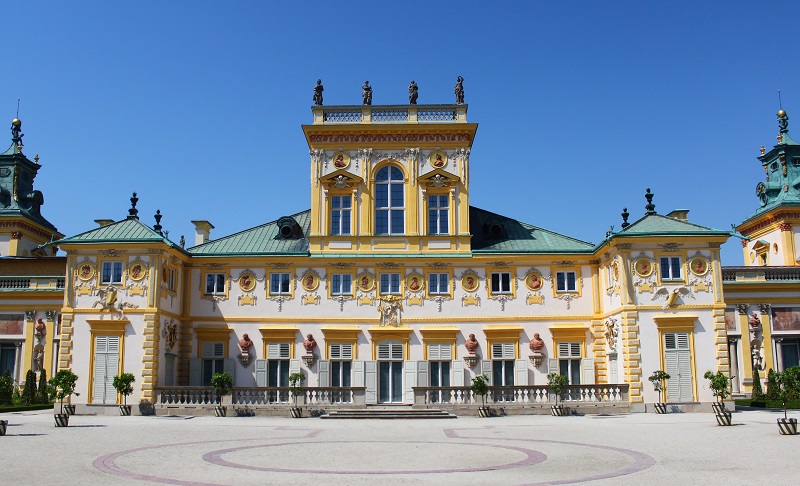
Immediately south of Warsaw is Wilanow, which was formerly the summer palace of the Polish kings. The castle was built in the current Baroque style at the end of the 17th century by King Jan III Sobieski. Since then, Wilanow has not changed, and it is today one of Poland’s most beautiful castles and facilities.
After the time of the Polish kings, Wilanow had a number of changing owners within the Polish nobility, and since 1945 it has belonged to the state. During the Second World War, Wilanow and its art and surroundings were almost destroyed, but a reconstruction of the castle and reconstruction of the park in the time until 1965 have brought the facility back to the condition it was in in the time of Jan III Sobieski, and already at the sight of the castle beautiful exterior you can see the beauty of the facility.
Inside the castle building itself, one can enjoy Wilanów’s very beautiful halls and decorations and see a number of works of art such as paintings, Etruscan vases and sculptures, as well as the portrait gallery of Polish kings and national heroes.
Wilanow’s park is also worth a walk. It contains statues, flower beds, a Chinese pavilion and, of course, fine greenery, which together with the castle form one of the pearls of the Warsaw area.
The small town of Konstancin-Jeziorna is a spa town located by springs with hot and mineral-rich salt water. The water in the city is taken from the underground, and the facility/Tężnia (Ulica Henryka Sienkiewicza) is designed so that you get the feeling of being by the sea.
During a stay in the city, you can also take a walk along the city’s avenues, where there are a number of well-to-do mansions. On such a trip, you can see for yourself that this is one of Warsaw’s finer suburbs.
The town grew up in the 18th century around a paper mill, which was the only one in the region. The official founding of the city took place in 1897. Today, the old paper mill is set up as the shopping center Stara Papiernia (Ulica Warszawska).
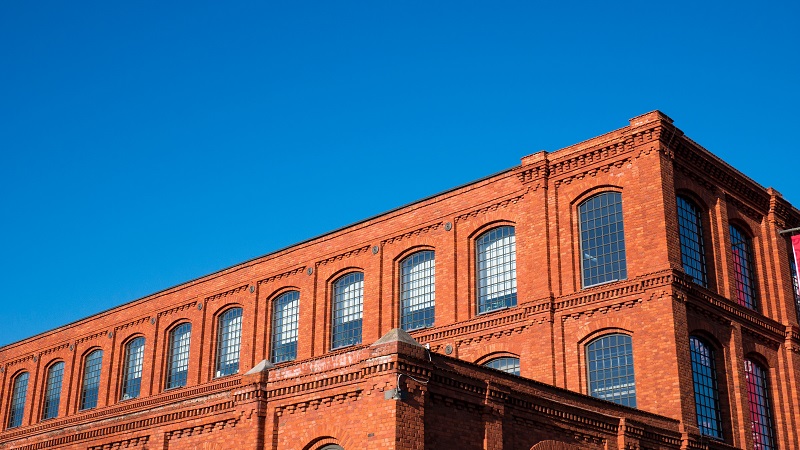
Łódź is one of Poland’s largest cities, and it is a city with an exciting history. The town was known as a small village from the 14th century, and King Władysław II Jagiełło granted it city rights in 1423. However, Łódź was subject to the bishops of the area until the end of the 18th century, after which it became part of Prussia in 1793 and from 1815 a part of the Congress Poland.
However, it was the industrialization of the 19th century that really left its mark on the development and prosperity of Łódź. The industrial growth brought many new inhabitants to the city, which became one of Poland’s largest. It was textile production in particular that brought production to Łódź, and over the years factories were built, which today constitute a characteristic feature of the cityscape.
The village of Zelazowa Wola is the birthplace of the composer Frederik Chopin. Here you can visit Chopin’s house, which is part of the Frederik Chopin Museum in Warsaw.
The house itself was an annex to Count Skarbek’s manor, and in 1810 Poland’s most famous composer was born. The house was put in place in the years between the two world wars of the 20th century, and now you can experience a depiction of Chopin’s life and works in the appropriate setting. In the summer, concerts of Chopin’s compositions are arranged.
Aleje Jana Pawła II 82
arkadia.com.pl
Aleje Jerozolimskie 179
bluecity.pl
Aleje Marszałkowska 104/122
galeriacentrum.com
Ulica Wołoska 12
galeriamokotow.pl
Ulica Ostrobramska 75c
promenada.com
Ulica Złota 59
zlotetarasy.pl
Ulica Krakowskie Przedmieście, Ulica Nowy Swiat, Aleje Jerozolimskie, Aleje Marszałkowska
Miejski Ogród Zoologiczny
ul. Ratuszowa 1/3
zoowarszawa.pl
Muzeum Kolejnictwa
ul. Towarowa 1
pkp.pl/muzeum
Wodny Park
Merliniego 4
wodnypark.com.pl
Warsaw is a relatively young city in the Polish context. Although there have been settlements on the site where trade routes from north to south and east to west cross the Wisla River, it was not until the 13th century that Mazurian dukes erected a fort on the site where the city’s royal palace is today.
Like the other Polish cities of the Middle Ages, Warsaw was built at the center of a marketplace and with streets facing the gates of a fortified city wall. All these parts of the town plan from that time can be seen in the old town today.
Until 1413, Warsaw was only a village, but when the Mazurian dukes moved their residence to the city, a long period of flourishing began. The city grew rapidly, and it grew to the north beyond the city walls.
However, Poland’s dominant city was in Warsaw’s first centuries Krakow, which was the center of the country both culturally, religiously and politically. Furthermore, when the last Mazurian duke died in 1526 without heirs to the throne, Warsaw was subject to Krakow’s control.
The political turning point and the foundation of Warsaw’s great growth occurred in the following centuries in 1569, when the Polish political administration Sejmen moved to Warsaw in connection with the formation of the Polish-Lithuanian Empire.
In 1596, Warsaw finally came out of the shadow of Krakow when Sigismund III Vasa moved the royal residence from Krakow to the castle in Warsaw. Sigismund III Vasa was a Swede and with the move he got closer to his motherland.
The 17th century was dominated by a beginning weakening for the Polish-Lithuanian Empire, and the country was invaded by Sweden in 1655-1660, where Warsaw was also partially destroyed in the fighting.
Warsaw was rebuilt after the devastation, and it marked the beginning of a long period of growth up through the 18th century, despite the fact that it was here that Poland-Lithuania went down and Poland was split between neighboring countries.
Several mansions, palaces, churches and monasteries were built and the kingdom flourished, especially in the decades before its demise.
At the end of the long growth period, Warsaw had 120,000 inhabitants and it was Poland’s dominant city. By the Polish divisions, Warsaw came under Prussian rule and was reduced to a provincial city.
During Napoleon’s advance towards his eastern goal Moscow, the Duchy of Warsaw was established and the city became the capital. After the Vienna Congress, Warsaw continued for a brief period as its capital until it became part of the Russian Empire – a status that lasted until World War I and the Russian Revolution in 1917.
At the end of the 19th century, Warsaw experienced a period of growth in the industrialization of the country. Among other things, the first railway was opened from Vienna across Warsaw to the residence of the tsar Skt. Petersburg. The city’s population had increased to 680,000 in 1900.
After World War I, Poland was re-established as an independent state and Warsaw became the country’s capital. Within the first 20 years, until the start of World War II, a violent development occurred in Warsaw. Industry, education, culture and science boomed, and the population rose to 1,250,000.
During World War II, Warsaw fell after less than a month of fighting. 1943 was the year of the uprising in the Jewish ghetto, which was destroyed after fierce fighting. Around the arrival of the Soviet army in late 1944, the second uprising began in the city, which, together with the Red Army troops, overcame the German military. The German withdrawal caused enormous losses, with the Germans demolishing many buildings to destroy the city.
World War II cost about 700,000 of the city’s inhabitants, up to 85% of Warsaw’s buildings were destroyed, and after the war there was a tremendous rebuilding work in front of the inhabitants and the new state politically led by the Communist Party.
It was quickly decided to rebuild the city’s old town and other important historical monuments. All the citizens of the city participated, and the business is unique in history, while at the same time building a modern city with infrastructure and lots of new housing.
During the first decades after the war, the most significant parts of the impressive work were completed, and therefore visitors today still experience the charming old Warsaw.
Warsaw is today the capital of a Poland, which since the fall of communism has experienced strong growth in a European Union, with the Polish capital one of the major capitals of Eastern Europe. Modern buildings, shopping malls and other things have shot up, and Warsaw has hosted many, many great events such as the opening match of the European Football Championships in 2012.
 Warsaw, Poland[/caption]
Warsaw, Poland[/caption]
Overview of Warsaw
Warsaw or Warszawa is the capital of Poland and one of Eastern Europe’s great and historic capitals, and not many places like this city have experienced so turbulent times. In recent centuries, Warsaw has undergone several divisions and takeovers of power in Poland, and more recently about 85% of Warsaw was destroyed during World War II.
Time and again, the city has been rebuilt, and today the many beautiful buildings of historic Warsaw stand again in their original and noble exterior. The major investment in new construction in recent decades has provided a further dimension with a great architectural mix where the historical and new meet.
Fine museums depict, among other things, the turbulent years of war, but art museums and some of the many mansions and palaces are also worth a visit. There is also a huge selection of shopping and dining options, all with the warm Polish atmosphere and tasy food as the centerpiece.
About the Whitehorse travel guide
Contents: Tours in the city + tours in the surrounding area
Published: Released soon
Author: Stig Albeck
Publisher: Vamados.com
Language: English
About the travel guide
The Whitehorse travel guide gives you an overview of the sights and activities of the Canadian city. Read about top sights and other sights, and get a tour guide with tour suggestions and detailed descriptions of all the city’s most important churches, monuments, mansions, museums, etc.
Whitehorse is waiting for you, and at vamados.com you can also find cheap flights and great deals on hotels for your trip. You just select your travel dates and then you get flight and accommodation suggestions in and around the city.
Read more about Whitehorse and Canada
Canada Travel Guide: https://vamados.com/canada
City tourism: https://visitwhite-horse.ca
Main Page: https://www.vamados.com/
Buy the travel guide
Click the “Add to Cart” button to purchase the travel guide. After that you will come to the payment, where you enter the purchase and payment information. Upon payment of the travel guide, you will immediately receive a receipt with a link to download your purchase. You can download the travel guide immediately or use the download link in the email later.
Use the travel guide
When you buy the travel guide to Whitehorse you get the book online so you can have it on your phone, tablet or computer – and of course you can choose to print it. Use the maps and tour suggestions and you will have a good and content-rich journey.


The Palace Square in Warsaw is located at the southern entrance to the Old Town proper. In the castle square, the 22 meter high Sigismund column from 1643-1644 can be seen. It was erected on the occasion of the move of the country’s capital to Warsaw.
Originally, the Corinthian column was made of red marble, but during the reconstruction in 1948-1949 granite was used instead. At the same time, the column was moved slightly so that it forms a beautiful focal point from the streets Podwale and Ulica Krakowskie Przedmieście.
Warsaw Cathedral was built during the 1300s and 1500s as an ordinary parish church. The building was a typical example of brick church construction in Mazovia, which is a historical region around Warsaw.
In 1798, it became the city’s cathedral, among other things after many major events had taken place here, e.g. the coronation of King Stanislav August Poniatowski in 1764 and the lower house, the Sejmen, swearing in the 1791 constitution.
The church was destroyed in 1944 but rebuilt as the original Gothic church in the years up to 1954. Many artists have helped decorate the church through individual parts.
Warsaw’s city history museum is housed in no less than eleven townhouses on the north side of the Old Town Market Square. The houses are all reconstructions after the almost total destruction of the area during the Second World War.
At the museum, you can see a permanent exhibition of the so-called seven ages of Warsaw, many of which focus on the city’s destruction during World War II and the colossal efforts to rebuild it in the following decades.
There are also paintings, sculptures, models, descriptions of leading citizens from the city’s history, pictures of buildings from the now-disappeared Warsaw and much more.

New Town Market Square is, as the name suggests, a market place in the so-called Nye By, which was a district that was founded at the beginning of the 15th century. The district was then outside the old town, which forms the oldest Warsaw. In the period 1680-1818, this town’s town hall was located on the square.
After the destruction during the Second World War, they chose to recreate the square in a style mainly from the 1700s and 1800s.
On the new market square you will find the white St. Kazimir’s Church, built in the years 1688-1692 under King Jan III Sobieski and according to drawings by Tylman van Gameren. The church is built in late baroque style, and here you can see, among other things, the grave of Jan III Sobieski’s granddaughter, Princess Marie Caroline de Bouillon. The church was destroyed in 1944, and after the end of World War II, it was rebuilt. The interior is a mixture of historical things and elements chosen during the interior design in the 1960s.
This church is the representative cathedral of Poland’s army, but its history goes back to the Piarists in the 17th century. Under King Władysław IV, the monks were given the right to build a new church on a piece of land very close to the city center.
The Piarists started the construction of the present church in 1660, and the Italian Constantino Tencalla is believed to have been the architect of the construction. The church was built for both the Piarists themselves, but also for teachers and students at the school Collegium Nobilium, which they had also established.
Construction lasted until 1682 due to a challenged economy, while the interior could only be completed in 1701. In the same year, the bishop of Poznan, Mikołaj Święcicki, consecrated the church. However, the long planning and construction time meant that the baroque used was not modern after a short time, and the church was therefore rebuilt in classicism in 1730.
After the November Uprising in Poland 1830-1831 against Russia, the church was confiscated and it was converted into a Russian Orthodox church. The most visible sign of this was the five onion domes that adorned the roof of the church, and in general the Russian reconstruction in the 1830s created a beautiful building with inspiration from the Russian Baroque, which is known not least from Saint Petersburg.
In connection with Polish independence after World War I, the church was reconstructed according to 17th-century drawings, but after bombings during World War II, the church had to be completely rebuilt between 1946 and 1960.
Bank Square is one of Warsaw’s large and central squares, and over the past centuries it has been one of the political, financial and cultural focal points of the city. In the middle of the square stands a statue of the Polish poet, Juliusz Słowacki, who wrote in the Romantic period in the 1800s. Around the square are several interesting buildings.
The Government Financial Palace/Pałac Komisji Rządowej Przychodów in Skarbu (Plac Bankowy 5) is a large classicist mansion with a Greek-inspired temple-style facade with protruding colonnaded halls. It was built in 1825 and erected to house a government commission, equivalent to today’s Ministry of Finance. The mansion was destroyed during World War II and rebuilt after the war. It is today the seat of the President of Warsaw and of the city government.
The Ministry of Finance/Pałac Ministra Skarbu (Plac Bankowy 3) is located in another of the square’s large and beautiful mansions. The building was built with inspiration from the Italian Renaissance 1825-1828 as an administration and seat for the Minister of Finance. Today, just like the neighboring building to the north, it is used as administrative premises for the Warsaw City Council.
Gmach d. Banku Polskiego in Giełdy (Plac Bankowy 1, ulica Elektoralna 2) is a former bank and stock exchange building, which is one of the finest examples of classicism in Warsaw. It was built in the years 1825-1828 according to Antonio Corazzi’s drawings. It was soon after expanded. Today, it stands out particularly beautifully in the streetscape with its arcades on two floors.
From 1957 to 1981, the building housed a museum of Poland’s revolutionary history, while today you can see the art museum John Paul II Collection/Kolekcja Imienia Jana Pawla 2. The collection, which was the private property of the Porczynski family, was donated to Poland and opened to the public in 1990. The collection contains around 450 paintings from the Renaissance to Impressionism, including works by, among others, Rubens and Rembrandt.
This is one of the museums dealing with the colossal significance of the Second World War for the Polish population and Warsaw. The name Pawiak alludes to the German Gestapo prison in the city in the years 1939-1945. Members of the Polish resistance movement against the German occupation were brought here, and in total more than 100,000 people passed through the prison. Outside the entrance to Pawiak, there is a monument commemorating the victims of the prison.
Historically, Pawiak was built as a prison 1829-1835. It served in 1863 as a transit point for the deportation of prisoners to Siberia, and in the Polish interwar period it was the city’s primary prison for male criminals. Today you cannot see some of the old prison buildings. The word Pawiak itself derives from the street’s former name, Ulica Pawia, meaning Peacock Street.
This mansion was built 1643-1645 as a residence for the commander of the Polish army. From the end of the 17th century until 1817, it belonged to the Radziwiłł family, and it was extended several times. The current appearance derives mainly from the last major rebuilding, in 1818-1819.
It was here in the building that the official agreement on the establishment of defense cooperation, the Warsaw Pact, was signed in 1955, thereby entering the Cold War era in the international history books. Since 1994, the beautiful facility has been the residence of the President of Poland.
In front of the palace stands an equestrian statue made in 1832 by the Danish artist Bertel Thorvaldsen; it depicts Prince Józef Poniatowski. The statue was destroyed during World War II and after the war a new casting was given as a gift from the citizens of the Danish capital, Copenhagen.

Kościół Świętego Krzyża is one of Warsaw’s most beautiful and impressive baroque churches. The elegantly decorated facade is one of the characteristic architectural highlights along the street Ulica Krakowskie Przedmieście.
There have been several churches on the site before the current one. The first was a wooden church from the 15th century, but as time went on, the city grew and with it the need for larger churches. During the ravages of the Swedes in the 1650s, the then church was destroyed, so a new one had to be built.
The baroque church was then built in the years 1679-1696 according to the design of the court architect Józef Szymon Bellotti. It included a modest exterior in the style of the Renaissance churches in the area, but the Baroque decoration and the appearance of the towers were soon added; it happened after two rebuilds in the 18th century.
On the facade you can see the figure of the church with Jesus and the cross, from which the name Holy Cross Church comes. The exterior design today is otherwise a simplified version of the church that was severely destroyed during World War II by German explosions. Inside, the formerly richly decorated room has not been recreated, but you can see a recreation of the church’s beautiful altar, where Tylman van Gameren’s National Altar/Ołtarz Ojczyzny from around the year 1700 was a model. In the church, an urn with composer Frederik Chopin’s heart has also been inserted into the wall.
Saint Joseph’s Church is one of Warsaw’s most beautiful churches from the Rococo period, and it stands as one of the distinctive buildings on the distinguished street, Ulica Krakowskie Przedmieście.
The first church on the site was a wooden church established in 1651 at the behest of the Polish Queen Marie Louise Gonzaga de Nevers, who established it for the Visitationists. For this reason, the church is also called the Visitation church/Kościół Wizytek.
The wooden church was burned during the Swedish invasion in the latter half of the 1650s, and a new one was founded in 1664. However, this church was not completed until it burned in 1695. It gave way to the current church, which was built from 1728 to completion in 1765.
The church’s interior offers both baroque and rococo, which is what the building is best known for. Sculptures, stucco, pulpit and the altar are all created by Efraim Szroeger, while you can enjoy works of art by several different Polish and foreign artists. The church’s tabernacle originally stood in the chapel of the Villa Regia in Warsaw, and it was donated here by Marie Louise Gonzaga de Nevers in 1654. The Villa Regia was the forerunner of the city’s university, which is also located on the street Ulica Krakowskie Przedmieście.
Behind the Tomb of the Unknown Soldier lies Warsaw’s first public park, the Saxon Garden, which was laid out in 1727. It was originally laid out according to French and Saxon models, but in the 19th century it was converted into a landscape garden.
Ogród Saski was previously laid out with bastions as part of Warsaw’s defense lines, but the area became a private park with the Morsztyn family building their residence here from 1666. The Saxon kings, Augustus II and Augustus III, expanded the garden and laid out, among other things, the avenues and other facilities here.
Similar to Warsaw Travel Guide
